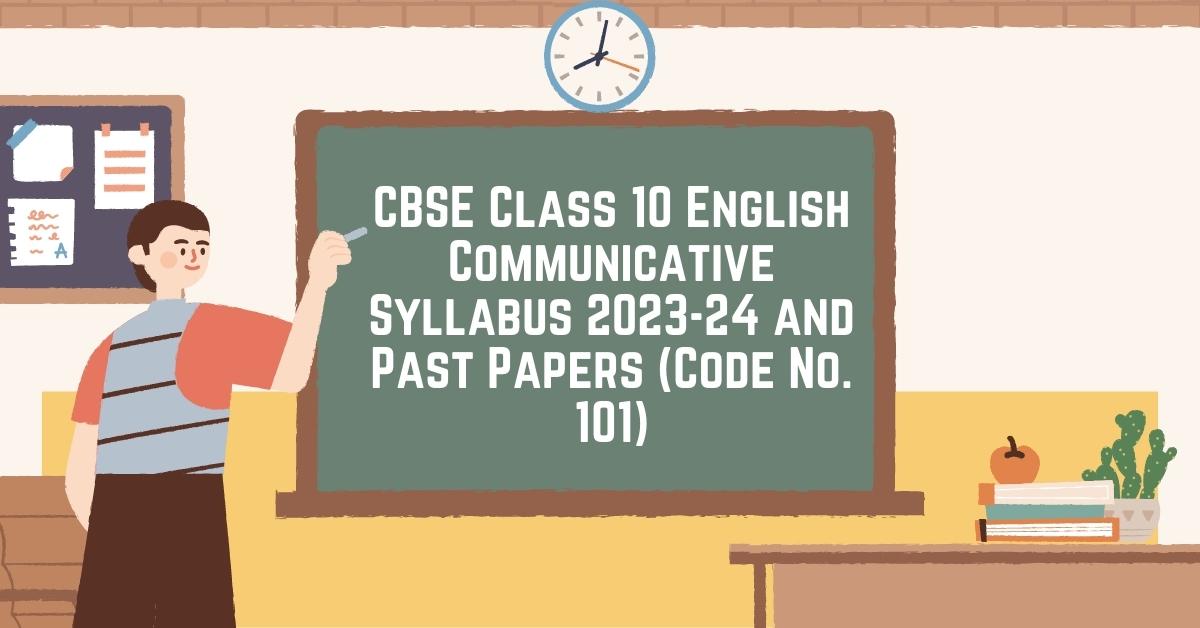CBSE Class X English Communicative (Code No. 101) Syllabus 2024-25. Check out CBSE Class 10 English Communicative Syllabus, CBSE Class 10th English Communicative Previous year question papers, CBSE Class 10th English Communicative Sample Papers and marking scheme.
Check out CBSE Class 10 Syllabus and Past Papers of other CBSE Class 10th Course CBSE Class 10th Science Syllabus 2024-25 and Past Papers, CBSE Class 10th Mathematics Syllabus 2024-25 and Past Papers, CBSE Class 10th English Language And Literature Syllabus 2024-25 and Past Papers, CBSE Class 10th English Communicative Syllabus 2024-25 and Past Papers, CBSE Class 10th Social Science Syllabus 2024-25 and Past Papers or check out CBSE Class 10th Previous Year Question Papers and Sample Papers Solved. Continue to read for CBSE Class 10th Syllabus Social Science.
CBSE Class 10 English Communicative (Code No. 101) Section Wise Weightage 2024-25
| Section | Total Weightage 80 | |
| A | Reading Skills | 22 |
| B | Writing Skills | 22 |
| C | Grammar | 10 |
| D | Literature Textbook | 26 |
| TOTAL | 80 |
Note: The Board examination will be of 80 marks, with a duration of three hours.
English Communicative Exam Paper Format And English Communicative Syllabus 2024-25
Section A: Reading
Periods 50
Weightage: 12+ 10 = 22 Marks
| Type | Marks |
| This section will have two unseen passages of a total of 700-750 words. The passages can have continuous and non-continuous text inspired from the themes in prescribed books. | 12 |
| Objective Type Questions (including Multiple Choice Questions), Very Short Answer Type Questions (one word/ one phrase / one sentence) and Short Answer Type Questions (30-40 words each) will be asked to test interpretation, analysis, inference, evaluation and vocabulary in context. | 10 |
Section B: Writing Skills
Periods 50
Weightage: 22 Marks
- Email to school authorities (Application for leave/ change of subject /change of section/ bus-timings or similar topics) in maximum 50 words (3 Marks)
- Factual Description of a person/object in maximum 100 words (4 Marks)
- One out of two formal letters, in maximum 120 words, thematically aligned to topics in MCB. (7 Marks)
- One out of two articles based on verbal cues, in maximum 150 words, thematically aligned to MCB topics. (8 Marks)
Section C: Grammer
Periods 20
Weightage: 10 MarksThe Grammar syllabus will include the following areas in class X.
- Tenses
- Modals
- Use of passive voice
- Subject – verb concord
- Reporting
- Commands and requests
- Statements
- Questions
- Clauses:
- Noun clauses
- Adverb clauses
- Relative clauses
- Determiners
The above items may be tested through test types as given below:
- Gap filling (3 marks)
- Editing or Omission (4 marks)
- Sentences Reordering or Sentence Transformation in context. (3 marks)
Section D: Literature Textbook
Periods: 60
Weightage: 26 Marks
- Two out of three extracts from prose/poetry for reference to the context. Very Short Answer Questions will be asked to assess global comprehension, interpretation, inference and evaluation. (8 marks (4+4))
- Five Short Answer type Questions out of six from the Literature Reader to test local and global comprehension of theme and ideas, analysis, evaluation and appreciation (30-40 words each) (5 x2 = 10 Marks)
- One out of two Long Answer type Questions to assess how the values inherent in the text have been brought out. Creativity, evaluation and extrapolation beyond the text and across the texts will be assessed. This can also be a passage-based question taken from a situation/plot from the texts. (150 words). (8 marks)
CBSE Class 10th English Communicative Prescribed Books
INTERACT IN ENGLISH SERIES Published by CBSE, New Delhi
- Main Course Book (Revised Edition)
- Workbook (Revised Edition)
- Literature Reader (Revised Edition)
Class X English Communicative Competencies
| Testing competencies/ learning outcomes | Marks |
| Demonstrative Knowledge + Understanding (Knowledge based simple recall questions, to know specific facts, terms, concepts, principles or theories, identify, define, or recite, information, Comprehension – to be familiar with meaning and to understand conceptually, interpret, compare, contrast, explain, paraphrase information) | Upto 30% |
| Conceptual Application (Use abstract information in concrete situation, to apply knowledge to new situations; use given content to interpret a situation, provide an example or solve a problem) | Upto 35% |
| Analysis, Evaluation and Creativity Analysis & Synthesis- classify, compare, contrast, or differentiate between different pieces of information;organize and/or integrate unique pieces of information from a variety of sources. | Upto 35% |
| Total | 100% |








Be the first one to comment on this story.